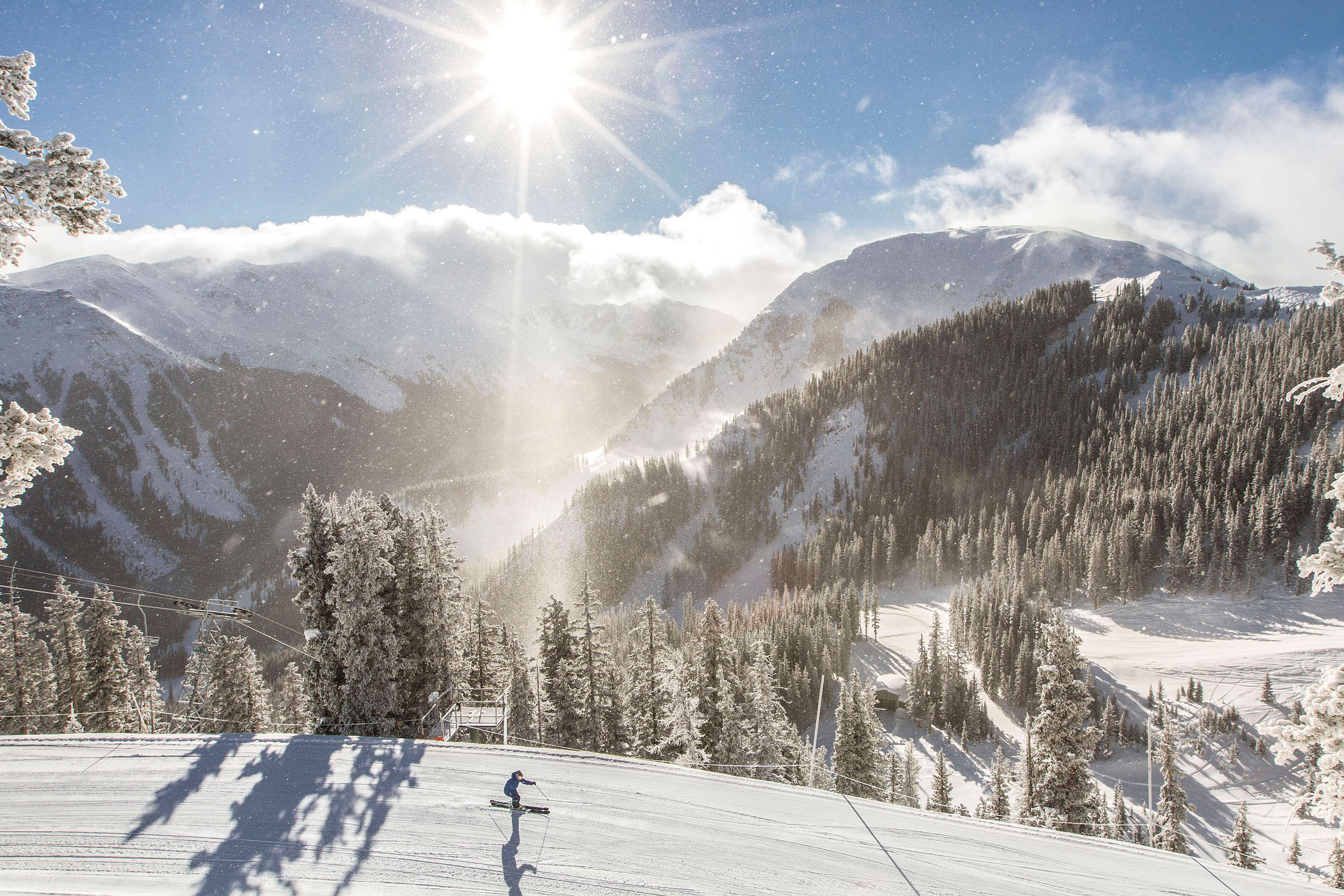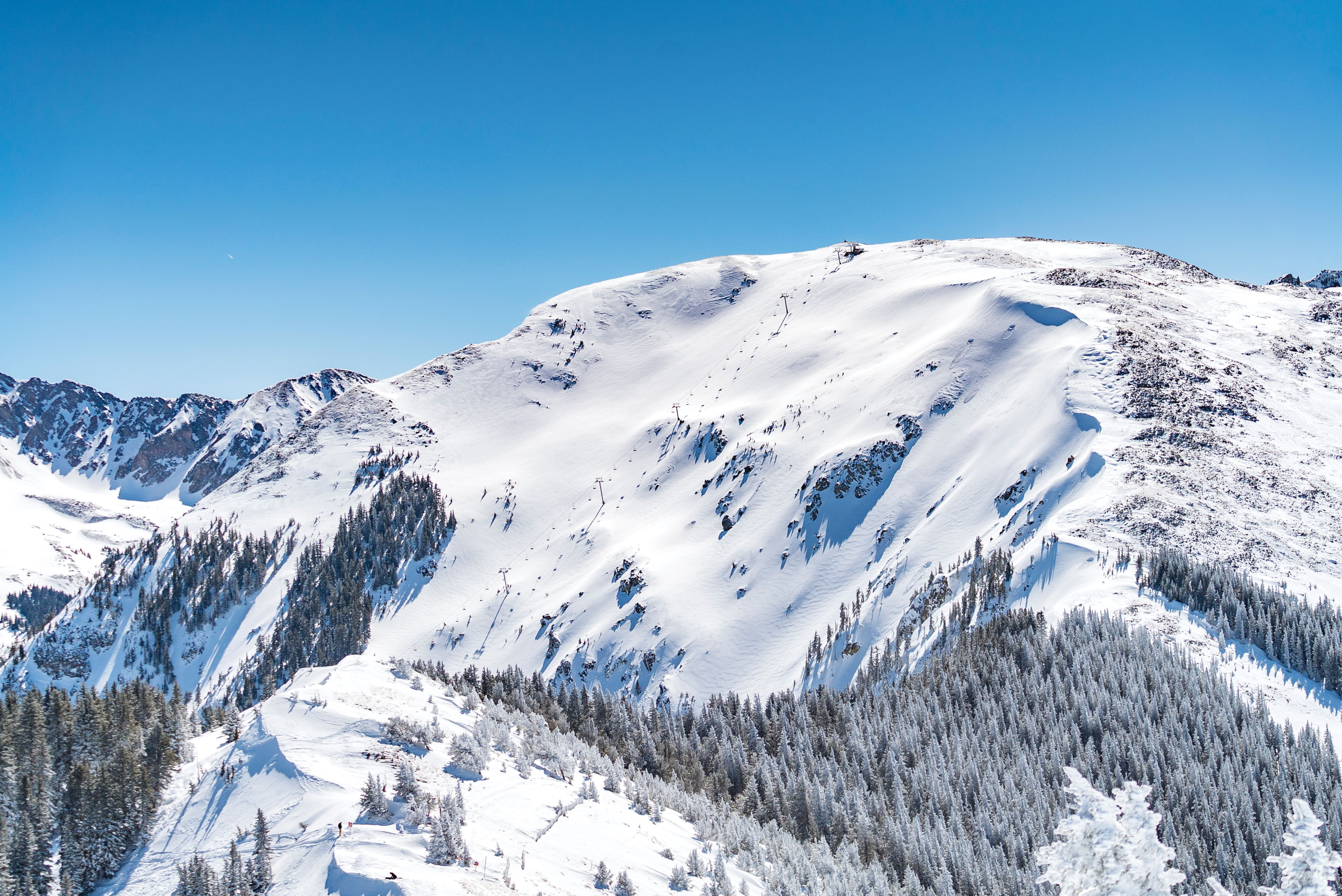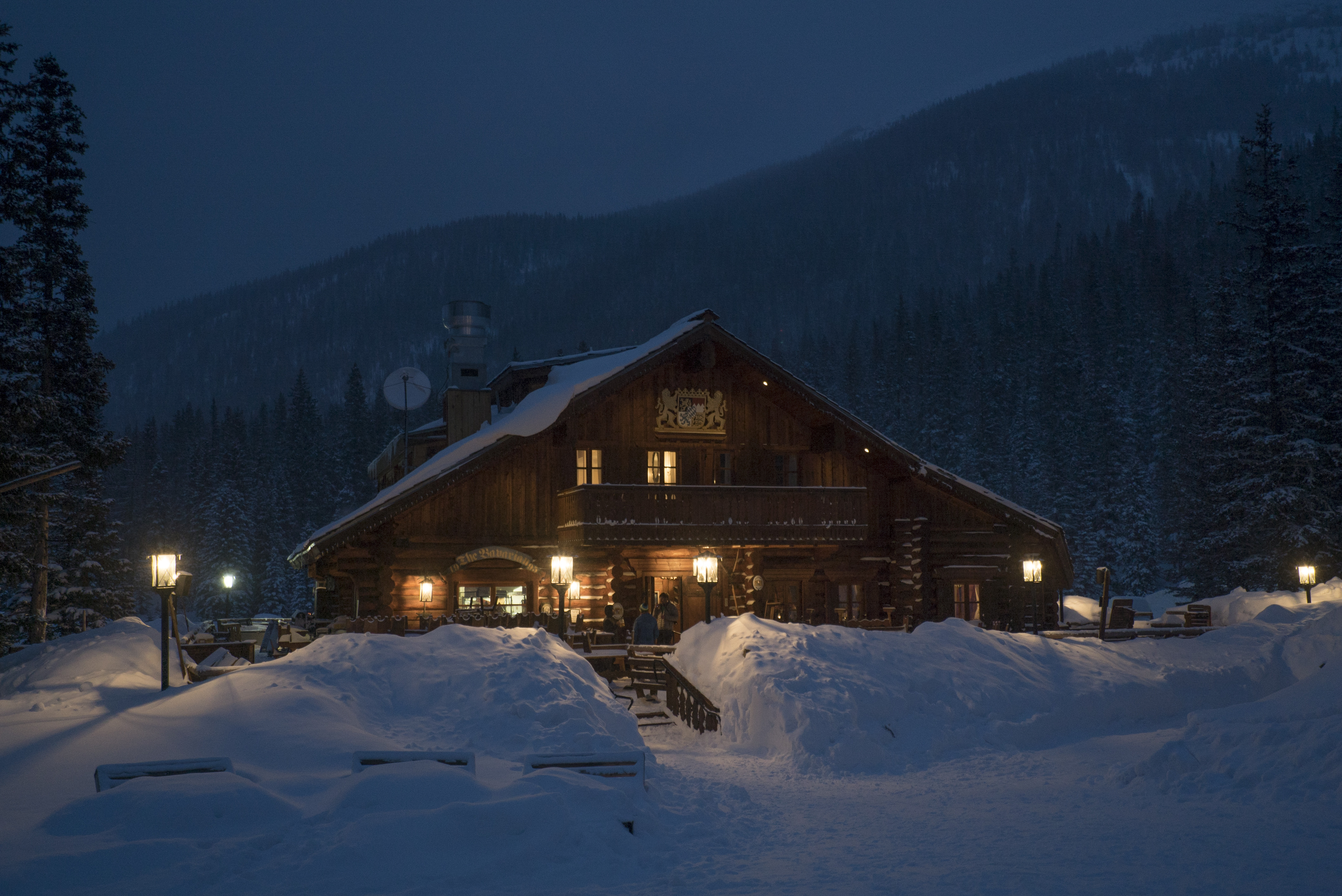Skiing in New Mexico presents an experience distinct from any other. From the moment you ascend on a chairlift in New Mexico’s Ski Valley, the unique atmosphere becomes palpable. The light is remarkably brighter, the mountains resonate with a serene quiet, and the expansive desert skies offer a nuanced backdrop to the exhilarating skiing in the Sangre de Cristo Mountains. Beyond the slopes, the rich culture and deep history of this region create an unparalleled mountain town experience.
Having explored mountain ranges across the globe—from Oregon, Washington, California, Utah, and Montana in the US, to adventures in Alaska, Japan, Russia, and throughout Europe—in a constant pursuit of formidable mountains and abundant powder, my arrival at Taos Ski Valley was truly singular. While New Mexico boasts several exceptional ski destinations throughout the state, Taos stands out as the premier location for challenging terrain and a world-class skiing experience. It’s no coincidence that the Freeskiing World Tour annually chooses these slopes for competition. Taos Ski Valley proudly offers 3,300 vertical feet of skiable terrain across 1,281 acres, with over half designated for expert skiers. Adding to its allure, the valley averages 300 inches of snowfall each year (though recent averages are closer to 200 inches) and enjoys 300 days of sunshine, promising a season that can extend from early December to early April.
The legendary reputation of Taos—known for its steep runs, captivating culture, and excellent margaritas—had long been on my radar. However, its somewhat remote location and the perceived inconsistency of snowfall had previously deterred a visit. It was a connection with someone special that finally drew me to this unique destination.
My New Mexico chapter began in Aspen, Colorado. Earlier that winter, while enjoying the slopes of Alta, Utah, I had the pleasure of meeting a woman residing in Santa Fe. At the time, I was the editor of Powder, “The Skier’s Magazine.” An assignment brought me to Aspen, and this woman extended an invitation to meet and then journey with her to New Mexico for my inaugural experience of its famed ski valley.
I vividly recall that day. We started with breakfast at Tune-Up in Santa Fe. Alongside huevos rancheros, prepared over easy and smothered in both red and green chili (“Christmas”), we shared a pupusa. Unable to finish it, I wrapped the remaining pupusa in foil and tucked the warm treat into my jacket pocket. Upon reaching Taos Ski Valley, I followed my new companion on the bootpack to West Basin, a ridgeline renowned for its technical skiing—characterized by narrow, steep, and rocky chutes. Despite a recent lack of snowfall, the north-facing slope retained cold, chalky snow, perfect for carving into. Throughout the afternoon, we reveled in the exhilarating chutes of this area, feeling as though we had the entire mountain to ourselves. Lift lines were nonexistent. The lift operators, grooving to reggae rhythms, offered knowing nods as we boarded the chairlift. It was a flawless, cloudless March day. The vista from Highline Ridge showcased the breathtaking expanse of the Sangre de Cristo mountain range.
On our final lift ride, we encountered a telemark skier named Dan, distinguished by his beard. I offered him a piece of my pocket pupusa. Dan and I soon discovered a mutual friend, and he enthusiastically convinced us to take one more run down West Basin with him. Afterwards, we relaxed on the deck of the Bavarian, indulging in steins of pilsner and savory, soft pretzels. On our drive back to Santa Fe, we made a stop at Taos Mesa Brewery, Dan’s establishment, where we enjoyed a beer and received a tour of his unique restaurant near the Río Grande Gorge.
That visit marked a beginning—personally for me, but also for Taos Ski Valley. Just a couple of months later, David Norden was appointed as the new CEO of the ski area, tasked with spearheading a transformation of the resort. Change was on the horizon.
 Skiers at Taos Ski Valley
Skiers at Taos Ski Valley
CHALLENGING PERCEPTIONS AND EMBRACING MODERNIZATION
Despite its proximity to the famed Colorado Rockies, Taos Ski Valley contends with a perception challenge in the mainstream ski community. A telling scene from an episode of Better Call Saul, set and filmed in Albuquerque, illustrates this point. The protagonist attends a cocktail party at his partner Kim’s law office and overhears a conversation about an upcoming company retreat. Suggestions range from Santa Fe’s Ten Thousand Waves spa to Carlsbad Caverns. However, Rick, a partner at the firm, envisions something more extravagant—Taos Ski Valley. Jimmy, the main character, responds with a hesitant, “Taos … that’s nice,” before asserting, “If you’re up for adventure, you know where the great skiing is—it’s Telluride. The runs at Telluride, they make Taos look like a bunny slope.”
While Jimmy’s assessment is demonstrably inaccurate, the sentiment reflects a common misconception. Moreover, even exceptional terrain is inconsequential without snow. Taos Ski Valley was recently challenged by its least snowy winter on record, accumulating only 80 inches of snowfall. Extensive and resource-intensive snowmaking efforts were employed to maintain open pistes, yet the season resulted in significant financial losses. Although this past season was an outlier, climate change presents a growing concern, potentially leading to more frequent snowfall irregularities, especially at these southern latitudes.
“Last year appears to be the worst year since record-keeping began in the 1890s,” Norden shared with me last fall. “If this is truly a once-in-a-100-year event, we can manage. But if this becomes a recurring event every five or ten years, we face serious challenges.”
I recall riding chairlifts over visibly bare slopes last January, contemplating whether it signaled the decline of skiing in the region. Regardless, Taos Ski Valley is committed to progress and is moving forward with substantial enhancements. This past summer marked the completion of the second phase of a multi-year, $300 million investment initiative. The ski area unveiled its first high-speed quad lift, replacing the original Lift 1, and renovated the Bavarian and Phoenix restaurants. Investments in snowmaking have also doubled, with the addition of 30 new tower guns and 50 new hydrants. These advancements build upon previous improvements, including the February 2017 opening of the luxurious, LEED Silver-certified Blake Hotel, a new children’s center, and a “gondolita” connecting the beginner area to the main base. Further expansion continues with new condominiums planned to open in 2020, and the groundbreaking announcement of Taos Air in October, launching daily flights from Taos to Dallas and Austin, commencing this winter season.
Explore More: Expert Skiing Tips for New Mexico.
Taos Ski Valley is undeniably in a state of evolution. Norden’s vision is to navigate these changes while preserving the essence of what makes Taos Ski Valley cherished by locals and loyal visitors. His mission is to enhance infrastructure and broaden skier appeal without compromising the unique culture and atmosphere. He describes this delicate balance as his paramount challenge.
“Our primary directive is to evolve the resort without altering its fundamental character,” he explains. “However, our facilities were aging and inadequate, leading to a 20-year decline in annual visitation, reaching a point of economic unsustainability. Economic viability is crucial for long-term sustainability. Therefore, we are revitalizing the resort.”
Norden emphasizes that the company’s objectives extend beyond mere profitability. The aim is to create a positive impact that resonates beyond business success. In February 2017, Taos Ski Valley achieved a significant milestone, becoming the first ski resort globally to be certified as a B Corporation. This designation reflects its commitment to “rigorous standards of social and environmental performance, accountability, and transparency.” Between 2014 and 2016, the ski area successfully reduced its energy consumption by 11 percent, setting an ambitious goal to further decrease it by 20 percent by 2020.
 Taos Ski Valley
Taos Ski Valley
To mitigate the unpredictability of winter seasons, Taos Ski Valley is strategically diversifying its offerings by developing year-round activities. Enhancements include improvements to the popular Williams Lake hiking trail, the installation of a via ferrata—a protected climbing route with steel cables—and the development of two beginner and intermediate flow trails for mountain biking. Ultimately, in collaboration with the U.S. Forest Service, the resort plans to offer 15 miles of lift-accessed mountain biking trails.
Expanding into summer activities is a common strategy among ski resorts, but the scale of investment at Taos Ski Valley is noteworthy, especially for an independently owned resort. The ski industry is undergoing significant consolidation. Faced with fluctuating skier numbers, inconsistent snowfall, and evolving consumer preferences, mid-sized ski areas increasingly struggle to generate sufficient capital for necessary upgrades. Currently, four major corporations control 46 of the most prominent ski resorts in the United States. Two of these, Vail Resorts and Alterra Mountain Co., are actively acquiring ski areas and incorporating them into their season pass programs—the Epic Pass and Ikon Pass, respectively, with Taos Ski Valley now being part of the Ikon Pass. (Taos also remains affiliated with the Mountain Collective Pass for the upcoming season.) Recent acquisitions include Crested Butte, Crystal Mountain, and Stevens Pass.
Despite these industry shifts, the unique Taos Ski Valley experience persists. It’s an atmosphere. The lift operators exude enthusiasm. Slim Slidell, the ski patrol dummy atop Lift 2, humorously demonstrates self-arrest techniques for steep terrain. The lederhosen and dirndls at the Bavarian are authentic, and the selection of German beers is exceptional. Tim’s Stray Dog Cantina is rumored to serve the best huevos in New Mexico—and their cocktails are equally impressive. The St. Bernard offers a warm ambiance and live music. The Blake’s restaurant, 192, boasts incredible desserts, and Pizza Shack creates delicious, quick pizzas.
Read More: Discover New Mexico’s Smartest Ski Area.
Taos Ski Valley is a blend of character, unique cultural influences, and strong local pride. Down the valley, the town of Taos thrives with a vibrant and eclectic art scene, while Taos Pueblo, one of the oldest continuously inhabited communities in the country, presents an unparalleled cultural immersion. In an increasingly homogenized ski world, Taos offers an individuality unmatched by other destinations. This distinctive appeal initially drew me in and continues to captivate lifelong skiers in the Sangre de Cristo Mountains.
 Taos Ski Valley
Taos Ski Valley
 The Bavarian Lodge
The Bavarian Lodge
“I appreciate that it’s a bit different. I’ve been fortunate to ski at many incredible places and mountain towns across the West and in the Alps,” remarks Dave Hahn, Taos Ski Valley ski patroller and renowned mountain guide. “While Telluride and Aspen offer fantastic skiing and mountains, they share a certain sameness. Taos is quite distinct, owing to its New Mexico location, the fusion of cultures, the juxtaposition of mountains and desert, and its slightly off-the-beaten-path location. Many Americans are unaware that New Mexico is a state, let alone that it has snow, mountains, or skiing. These misconceptions provide a certain level of protection for us.”
Norden also recognizes this unique positioning. Denver is currently the fastest-growing market for Taos Ski Valley. The resort will continue to encourage Colorado skiers to venture south of the state line to discover an experience unlike anything available in the well-trodden I-70 corridor ski areas.
“If we succeed in our mission, we will maintain a destination that is significantly differentiated from the competition, as the mainstream resorts are becoming increasingly similar and larger,” he concludes. “We possess the culture, the scale, and an exceptional mountain.”
Get more inspiring stories like this delivered to your inbox. Subscribe today.
A LASTING LOVE AFFAIR WITH NEW MEXICO SKIING
Unbeknownst to me at the time, that initial trip to New Mexico marked the beginning of a deep affection—for the woman, for the Sangre de Cristo Mountains, and for Taos Ski Valley. The subsequent winter, I immersed myself in New Mexico life. The skies consistently delivered cold, powdery snow. I experienced powder skiing off the Kachina lift for the first time, an experience comparable to the legendary terrain of Jackson Hole or any top-tier ski area in the lower 48 states. The mountain revealed its wonders gradually and surprisingly.
Two years after that first visit, I resigned from my position at Powder, relocated to Santa Fe, and married the woman on the deck of the Bavarian following a day of midwinter skiing. We celebrated an après-ski wedding, sharing pilsners and pretzels with friends and family, and walking down a snow-covered aisle. Our reception followed at Dan’s brewery.
While last winter’s snowfall was less than ideal, our commitment to Taos and New Mexico is for the long term.
EXPLORE MORE NEW MEXICO SKI RESORTS
Angel Fire Resort Angelfireresort.com
Known for: Family-friendly atmosphere.
Where to eat/drink: Legends Grill, especially on Taco Tuesday, or El Jefe for lunch, or Enchanted Circle Brewing Company in town.
Vertical Feet: 2,077
Base Elevation: 8,600
Summit Elevation: 10,677
Skiable Acres: 560
Average Snowfall: 210 inches
Taos Ski Valley Skitaos.com
Known for: Challenging skiing, excellent learning center, great dining and bars, The Blake Hotel.
Where to eat/drink: Tim’s Stray Dog for breakfast or lunch and the Bavarian for après-ski.
Vertical Feet: 3,281
Base Elevation: 9,200
Summit Elevation: 12,481
Skiable Acres: 1,249
Average Snowfall: 300 inches
Ski Santa Fe Skisantafe.com
Known for: Superb tree skiing, excellent family programs.
Where to eat/drink: Totemoff’s at mid-mountain for chili and live music.
Vertical Feet: 1,725
Base Elevation: 10,350
Summit Elevation: 12,075
Skiable Acres: 660
Average Snowfall: 225 inches
Ski Apache Skiapache.com
Known for: Gondola access, owned by the Mescalero Apache Tribe, one of the southernmost ski resorts in the U.S.
Where to eat/drink: Spirit Bar for après-ski, Inn of the Mountain Gods Resort & Casino, Wendell’s for fine dining and live music. In Ruidoso, Win, Place, or Show for country music and Noisy Water Winery for local wines.
Vertical Feet: 1,900
Base Elevation: 9,600
Summit Elevation: 11,500
Skiable Acres: 750
Average Snowfall: 180 inches
Ski Sandia Peak Sandiapeak.com
Known for: Proximity to Albuquerque (30 minutes from downtown via tram), desert-to-peak tramway, beginner and family-friendly slopes.
Where to eat/drink: New restaurant opening soon on Sandia Crest. Sandiago’s Grill at the tram base for New Mexican cuisine, steaks, and seafood.
Vertical Feet: 1,700
Base Elevation: 8,678
Summit Elevation: 10,378
Skiable Acres: 200
Average Snowfall: 100 inches
Sipapu Ski and Summer Resort Sipapunm.com
Known for: Extremely family-friendly.
Where to eat/drink: Riverside Café in the historic lodge.
Vertical Feet: 1,055
Base Elevation: 8,200
Summit Elevation: 9.255
Skiable Acres: 200
Average Snowfall: 190 inches
Red River Ski & Summer Area Redriverskiarea.com
Known for: Family atmosphere, excellent ski school, slopes into town, laid-back rustic mountain culture.
Where to eat/drink: Red River Brewing Company or The Grill at the base for torchlight parades.
Vertical Feet: 1,600
Base Elevation: 8,750
Summit Elevation: 10,350
Skiable Acres: 209
Trails: 63
Average Snowfall: 214 inches
Pajarito Mountain Ski Area Pajarito.ski
Known for: Great tree skiing, fun family atmosphere, frequented by scientists.
Where to eat/drink: Bathtub Row Brewing Co-Op and El Rigoberto’s in Los Alamos.
Vertical Feet: 1,440
Base Elevation: 9,000
Summit Elevation: 10,440
Skiable Acres: 750
Average Snowfall: 125 inches